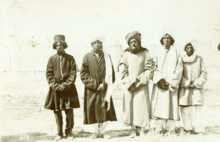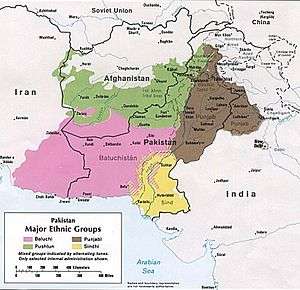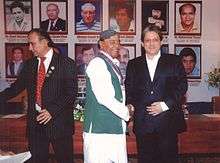Baloch people
 Sardar Ibrahim khan Sanjrani Iranian Baloch Khans in Qajar era, c. 1884 | |
| Regions with significant populations | |
|---|---|
| 6,900,000 (2013) | |
| 2,000,000[1][2] | |
| 468,000 (2014)[3] | |
| 312,000 (1993)[4] | |
| 300,000 (2009) | |
| 30,000 [5] | |
| Languages | |
|
Balochi Urdu, Sindhi, Seraiki, Brahui, Persian, Arabic and Pashto are also spoken depending on area of residence. | |
| Religion | |
| Predominantly Sunni Islam[6] | |
| Related ethnic groups | |
| Other Iranian peoples | |
The Baloch or Baluch (Balochi: بلوچ) are a people who live mainly in the Balochistan region of the southeastern-most edge of the Iranian plateau in Pakistan, Iran, and Afghanistan, as well as in the Arabian Peninsula.
They mainly speak the Balochi language, a branch of Northwestern Iranian languages, and are an Iranic people. About 50% of the total Baloch population live in Balochistan, a western province of Pakistan;[7] 40% of Baloch are settled in Sindh; and a significant number of Baloch people in Punjab of Pakistan. They make up nearly 3.6% of the Pakistani population, about 2% of Iran's population (1.5 million) and about 2% of Afghanistan's population.[8]
Baloch people co-inhabit desert and mountainous regions with Pashtuns, Baloch people practice Islam, are predominantly Sunni, and use Urdu as a lingua-franca to communicate with other ethnic groups, such as Pashtuns and Sindhis, similar to the rest of Pakistan.
Prominent Baloch people in Pakistan includes Prime Minister Zafarullah Khan Jamali and President Asif Ali Zardari who is an ethnic Baloch from Sindh. Iftikhar Muhammad Chaudhry born in Quetta, is the longest-serving Chief Justice of Pakistan is another prominent Baloch personality.
The son of Benazir Bhutto, Bilawal Bhutto Zardari is the Chief of the Baloch Zardari tribe.[9]
Etymology
The exact origin of the word 'Baloch' is unclear. Rawlinson (1873) believed that it is derived from the name of the Babylonian king and god Belus. Dames (1904) believed that it is derived from the Persian term for cockscomb, said to have been used as a crest on the helmets of Baloch troops in 6th century BCE. Herzfeld (1968) proposed that it is derived from the Median term brza-vaciya, which describes a loud or aggressive way of speaking. Naseer Dashti (2012) presents another possibility, that of being derived from the name of the ethnic group `Balaschik' living in Balashagan, between the Caspian Sea and Lake Van in present day Turkey and Azerbaizan, who are believed to have migrated to Balochistan during the Sassanid times.[10] The remnants of the original name such as 'Balochuk' and 'Balochiki' are said to be still used as ethnic names in Balochistan.[11]
Some writers suggest a derivation from Sanskrit words bal, meaning strength, and och meaning high or magnificent.[11] An earliest Sanskrit reference to the Baloch might be the Gwalior inscription of the Gurjara-Pratihara ruler Mihira Bhoja (r. 836–885), which says that the dynasty's founder Nagabhata I repelled a powerful army of Valacha Mlecchas, translated as "Baluch foreigners" by D. R. Bhandarkar. The army in question is that of the Umayyad Caliphate after the conquest of Sindh.[12]
History
According to Baloch lore, their ancestors hail from Aleppo in what is now Syria.[13] They are descendants of Hazrat Ameer Hamza, uncle of the prophet Muhammad, who settled in Halab (present-day Aleppo). and they fled to the Sistan region.[14] They allegedly remained there for nearly 500 years until they fled following a deception against the Sistan leader Badr-ud-Din to the Makran region.
However, based on an analysis of the linguistic connections of the Balochi language, which is one of the Western Iranian languages, the original homeland of the Balochi tribes was likely to the east or southeast of the central Caspian region. The Baloch began migrating towards the east in the late Sasanian period. The cause of the migration is unknown but may have been as a result of the generally unstable conditions in the Caspian area. The migrations occurred over several centuries.[15]
By the 9th century, Arab writers refer to the Baloch as living in the area between Kerman, Khorasan, Sistan, and Makran in what is now eastern Iran[16] Although they kept flocks of sheep, the Balochs also engaged in plundering travellers on the desert routes. This brought them into conflict with the Buyids, and later the Ghaznavids and the Seljuqs. Adud al-Dawla of the Buyid dynasty launched a punitive campaign against them and defeated them in 971-972. After this, the Baloch continued their eastward migration towards what is now Balochistan province of Pakistan, although some remained behind and there are still Baloch in eastern part of the Iranian Sistan-Baluchestan and Kerman provinces. By the 13/14th centuries waves of Baloch were moving into Sindh and by the 15th century into the Punjab.[16]
The area where the Baloch tribes settled was disputed between the Persian Safavids and the Mughal emperors. Although the Mughals managed to establish some control over the eastern parts of the area, by the 17th century, a tribal leader named Mir Hasan established himself as the first "Khan of the Baloch". In 1666, he was succeeded by Mir Aḥmad Khan Qambarani who established the Balochi Khanate of Kalat under the Ahmadzai dynasty.[note 1] Originally in alliance with the Mughals, the Khanate lost its autonomy in 1839 with the signing of a treaty with the British colonial government and the region effectively became part of British Raj.[16]
Balochi culture
The Balochi generally live in remote mountainous and desert regions, which have protected them from invasion and allowed them to form a distinct cultural identity. They are predominantly Sunni Muslims but a significant number in the Balochistan region are Shia Muslim. Balochi customs and traditions are conducted according to codes imposed by tribal laws. The Baloch men wear long shirts with long sleeves and loose pants. The dress is occasionally accompanied by a pagh (turban) or a hat on their heads.
In contrast to Pakistan, the Iran Balochi dress code is more conservative in sense of length and material. Some Baloch women in Iran also cover their faces with thick red color wools (Burqah) and wear a (Sareeg) which is the head scarf and (Chadar) which is a long veil.
Baloch women put on loose dresses and pants with sophisticated and colourful needlework, including a large pocket at the front of the dress to hold their accessories. The upper part of the dress and sleeves are also decorated with needlework, a form of artistry that is specific to the clothing of the Baloch women. Often the dress also contains round or square pieces of glass to further enhance the presentation. They cover their hair with a scarf, called a sarig in the local dialect.[22]
These customs are unique to the people of Iran and the art of this needlework on women's clothing may provide one with a picture of the freedom and high status of Baloch women in Achaemenid era.[23]
Gold ornaments such as necklaces and bracelets are an important aspect of Baloch women's traditions and among their most favoured items of jewellery are dorr, heavy earrings that are fastened to the head with gold chains so that the heavy weight will not cause harm to the ears. They usually wear a gold brooch (tasni) that is made by local jewellers in different shapes and sizes and is used to fasten the two parts of the dress together over the chest. In ancient times, especially during the pre-Islamic era, it was common for Baloch women to perform dances and sing folk songs at different events. The tradition of a Baloch mother singing lullabies to her children has played an important role in the transfer of knowledge from generation to generation since ancient times. Apart from the dressing style of the Baloch, indigenous and local traditions and customs are also of great importance to the Baloch.[24]
Geographic distribution

The total population of ethnic Baloch people is estimated to be around 15 million worldwide. However, the exact number of those who are Baloch or claim to be of Baloch ancestry is difficult to determine. As of 2012, the Baloch are 7.11% of Pakistan's 177 million people.
Baloch ancestry is also claimed in the neighboring areas that adjoin Baloch majority lands. Those who speak Brahui are known as Brahuis. Many Baloch outside of Balochistan are also bilingual or of mixed ancestry due to their proximity to other ethnic groups, including the Sindhis, Saraikis and Pashtuns. A large number of Baloch have been migrating to or living in provinces adjacent to Balochistan for centuries. In addition, there are many Baloch living in other parts of the world, with the bulk living in the GCC countries of the Persian Gulf. The Baloch are an important community in Oman, where they make up a sizable minority.
Many Baloch over the years have migrated to Punjab for its lush green fertility and they can be found in large numbers in South Punjab, Central Punjab and in Lahore but most of them identify themselves now as Punjabis. There is a small population of Baloch in several Western countries such as Sweden and Australia. Some Baloch settled in Australia in the 19th century; some fourth-generation Baloch still live there, mainly in the western city of Perth.
Baloch tribes

Divisions
As of 2008 it was estimated that there were between eight and nine million Baloch people living in Afghanistan, Iran and Pakistan. They were subdivided between over 130 tribes.[25] Some estimates put the figure at over 150 tribes, though estimates vary depending on how subtribes are counted.[26] The tribes, known as taman, are led by a tribal chief, the tumandar. Subtribes, known as paras, are led by a muquaddam.[27]
Jalal Khan, a legendary figure in the history of the Baloch people, led the Baloch from Persia to Makran. Khan had four sons, Rind, Hot, Lashari, and Korai, and a daughter, Jato. Five Baloch tribes derive their eponymous names from Khan's children. Many, if not all, Baloch tribes can be categorized as either Rind or Lashari based on their actual descent or historical tribal allegiances that developed into cross-generational relationships. This basic division was accentuated by a war lasting 30 years between the Rind and Lashari tribes in the 15th century.[28]
Tribalism
Violent intertribal competition has prevented any credible attempt at creating a nation-state. A myriad of militant secessionist movements, each loyal to their own tribal leader, threatens regional security and political stability. Nationalist and anti-tribal, egalitarian sentiments are inherently intertwined. Nationalist groups like the Baloch Students Organization, composed of armed rebels, and the Baloch Council of North America, made up of educated expatriates living in the United States, have simultaneously denounced Balochistan's traditional rulers and Pakistan's national government.[29][30][31] Baloch tribes are markedly less egalitarian than Pashtun tribes.[32] Balochistan National Party, a group that engages in politics and violence, makes a point of advocating on behalf of the tribally distinct Baloch communities in Iran and Afghanistan.[33]
Pakistan

There are 180,000 Bugti based in Dera Bugti. They are divided between the Rahija Bugti, Masori Bugti, Kalpar Bugti, and Daiga sub-tribes.[25][34] Nawab Akbar Khan Bugti led the Bugti as Tumandar until his death in 2006. Talal Akbar Bugti was the tribal leader and President of the Jamhoori Watan Party from 2006 until his death in 2015.[35] Brahumdagh Bugti serves as both Bugti tribal chief and head of the Baloch Republican Party.
There are 98,000 Marri based in Kohlo district,[25] who further divide themselves into Gazni Marri, Bejarani Marri, and Zarkon Marri.[25] Hyrbyair Marri has led the Balochistan Liberation Army since his brother's death in 2007. Another brother, Mehran Marri, leads the United Baloch Army. Both groups are designated terrorist organisations in Pakistan.
The Zehri are based in Zawa, Jhalawan where they are the largest tribe.[36] Sanaullah Zehri, the Chief Minister of Balochistan, is the Zehri's tribal chief. The Zehri have Sasoli and Zarakzai sub-tribes.
The Hooth tribe is led by Abdul Malik Baloch, the last Chief Minister of Baloch.
The Mengal tribe has the Shahizai, Zagar and Samalani sub-tribes. Ataullah Mengal leads the Mengal tribe.
See also
- Baloch people in the United Arab Emirates
- Balochistan Conflict
- Al Balushi
- Firoud
- Kai Khosrow
- Baloch cuisine
- Indo-Iranian peoples
Notes
- ↑ A number of unrelated tribes with the name Ahmadzai exist.[17] There are two Pashtun tribes who are unrelated to each other with this name: the Ahmadzai who are a Waziri tribe and the Sulaimankhel Ahmadzai, part of the Ghilzai confederation.[18] However, the Ahmadzai Khans of Khalat were neither of these and belonged to a Brahui tribe.[19][20][21]
References
- ↑ http://www.atimes.com/atimes/Middle_East/MID-02-201014.html
- ↑ Grassi, Daniele (20 October 2014). "Iran's Baloch insurgency and the IS". Asia Times Online. Retrieved 26 June 2015.
- ↑ "United Arab Emirates: Languages". Ethnologue.com. Retrieved 24 October 2016.
- ↑ "Oman: Languages". Ethnologue.com. Retrieved 24 October 2016.
- ↑ KOKAISLOVÁ, Pavla, KOKAISL Petr. Ethnic Identity of The Baloch People. Central Asia and The Caucasus. Journal of Social and Political Studies. Volume 13, Issue 3, 2012, p. 45-55., ISSN 1404-6091
- ↑ "Demography of Religion in the Gulf". Mehrdad Izady. 2013.
- ↑ Blood, Peter, ed. "Baloch". Pakistan: A Country Study. Washington: GPO for the Library of Congress, 1995.
- ↑ Central Intelligence Agency (2013). "The World Factbook: Ethnic Groups". Retrieved 3 November 2014.
- ↑ "Bilawal Bhutto Zardari to be new chief of Zardari tribe Formal tribal ceremony of Dastar Bandi". asianetpakistan.com. 27 May 2011. Retrieved 6 November 2011.
- ↑ Dashti, The Baloch and Balochistan 2012, pp. 8, 33–34, 44.
- 1 2 Dashti, The Baloch and Balochistan 2012, pp. 33–34.
- ↑ Bhandarkar, D. R. (1929). "Indian Studies No. I: Slow Progress of Islam Power in Ancient India". Annals of the Bhandarkar Oriental Research Institute. 10 (1/2): 30. JSTOR 41682407.
- ↑ Olson; et al. (1994). An Ethnohistorical Dictionary of the Russian and Soviet Empires. Greenwood Publishing Group. p. 101. ISBN 978-0313274978.
- ↑ Kreyenbroek, Philip G. (2010). Oral Literature of Iranian Languages: Kurdish, Pashto, Balochi, Ossetic, Persian and Tajik: Companion Volume II: History of Persian Literature A, Volume 18. I.B.Tauris. ISBN 978-0857732651.
The Baloch tribes rise up from their original home in Aleppo, all sons of Mir Hamza (generally taken to be the uncle of the prophet Muhammad) to fight against the second Ummayad Caliph Yazid I at Karbala in 680. After Hoseyn is slain, the angered Balochi tribes wander way eastwards
- ↑ J. Elfenbein (1988). "BALUCHISTAN iii. Baluchi Language and Literature". Encyclopedia Iranica. Retrieved 30 December 2014.
- 1 2 3 Spooner, Brian (1988). "BALUCHISTAN i. Geography, History and Ethnography". Encyclopedia Iranica. Retrieved 30 December 2014.
- ↑ Kieffer, Ch. M. "AḤMADZĪ". Encyclopædia Iranica (Online ed.). United States: Columbia University.
- ↑ "Ethnic Identity in Afghanistan". Naval Postgraduate School. Retrieved 3 January 2015.
- ↑ Bettina Bruns; Judith Miggelbrink (8 October 2011). Subverting Borders: Doing Research on Smuggling and Small-Scale Trade. Springer Science & Business Media. p. 52, footnote 12. ISBN 978-3-531-93273-6.
- ↑ Minahan, James (2012). Ethnic Groups of South Asia and the Pacific: An Encyclopedia. ABC-CLIO. p. 48. ISBN 978-1-59884-659-1.
- ↑ Axmann, Martin (2008). Back to the Future: The Khanate of Kalat and the Genesis of Baloch Nationalism, 1915-1955. Oxford University Press. p. 22. ISBN 978-0-19-547645-3.
- ↑ "People of Iran: A Cultural Anthropology of Balochis". Iranchamber.com. Retrieved 7 September 2010.
- ↑ "The World of Achaemenid Persia". Iranchamber.com. Retrieved 13 September 2010.
- ↑ "Baloch Society & culture". Baask.com. Archived from the original on 16 September 2011. Retrieved 7 September 2010.
- 1 2 3 4 Tahir, Muhammad (3 April 2008). "Tribes and Rebels: The Players in the Balochistan Insurgency". Jamestown.
- ↑ Baloch, Muhammad Amin (1999). Inside Ormara. Muhammad Amin Baloch. p. 83.
- ↑ Bonarjee, P. D. (1899). A handbook of the fighting races of India. Thacker, Spink & Co. p. 47.
- ↑ Asimov, M. S.; Bosworth, C. E. (1992). History of Civilizations of Central Asia (vol.4, part-1). Motilal Banarsidass Publishing. p. 305.
- ↑ Jugdep S. Chima (2015). Ethnic Subnationalist Insurgencies in South Asia: Identities, Interests and Challenges to State Authority. Routledge. p. 126. ISBN 978-1138839922.
- ↑ "Influential Baloch lobby group in US decides to end activism against Pakistan". Terminal X. 15 July 2014. Archived from the original on 22 December 2015.
- ↑ "Voice of Baloch Nationalists in powerful US congress". Pakistan Christian Post. 8 February 2012.
- ↑ Political Competition and Social Organization: Explaining the Effect of Ethnicity on Public Service Delivery in Pakistan Aisha Shafique. (The Ohio State University: 2013). Page 27.
- ↑ Malik Siraj Akbar (2011). The Redefined Dimensions of Baloch Nationalist Movement. Xlibris Corporation. p. 312.
- ↑ Pakistan Horizon, Volume 59, Issues 3-4. Pakistan Institute of International Affairs. 2006.
- ↑ "JWP leader Talal Bugti passes away in Quetta". The Express Tribune. 27 April 2015.
- ↑ Mary Anne Weaver (2010). Pakistan: In the Shadow of Jihad and Afghanistan. Macmillan. p. 104.
Bibliography
- Dashti, Naseer (2012), The Baloch and Balochistan: A Historical Account from the Beginning to the Fall of the Baloch State, Trafford Publishing, pp. 33–, ISBN 978-1-4669-5896-8
External links
| Wikimedia Commons has media related to Baloch. |
- "Iran". The World Factbook. Central Intelligence Agency.
- Baloch people at DMOZ
-
 Wikimedia Atlas of Iran
Wikimedia Atlas of Iran